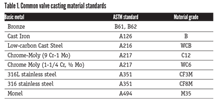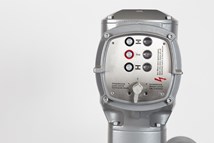Speakers Share Market Outlook for the Rest of 2019, 2020 and Beyond
Members attending the VMA Market Outlook Workshop, August 8-9 in San Diego, received good news and bad news about markets important to the valve industry, as well as recent overall economic conditions domestic and worldwide.
#VMAnews
U.S. AND GLOBAL ECONOMIES
One positive aspect that the speakers saw was continued growth, though at a slower pace, through the end of 2019 and perhaps well into 2020. The usual indicators of an imminent downturn either weren’t present or were behaving in unusual ways, several people said.
At the global level, many factors are currently causing some discomfort, according to David Teolis, assistant director, international economics for General Motors Company. Those include: Will the U.S. trade war with China extend to other countries? How much longer will it last? What will happen as global manufacturing activity slows? Can central banks’ monetary policy be effective? What will the effects of elections, geo-political events and technological changes be? The increase in uncertainty has accelerated during 2019, Teolis said.
After ten years, the U.S. economy continues on its longest recovery period since World War II. This growth is persisting going forward, though at a decreasing rate, said Giacomo Rondina, UC San Diego. Also, the overall growth rate of gross domestic product (GDP) during the current recovery has been lower than other post World War II recoveries. The next-longest postwar recovery lasted ten years (1991–2001) and showed total GDP growth of about 30%. The current decade of recovery has yielded closer to 20%, Rondina said.
PROCESS CONTROLS
Michael Halloran, senior research analyst at Baird offered a Wall Street perspective on industries that use valves. Halloran follows 21 publicly held companies in the process controls sector.
With political and trade tensions high, Halloran sees massive concern about the economy at large. “[This is] the most chaos I’ve seen without a recession,” he said.
Halloran showed PMI [purchasing manager index] and other data indicating that the economy is late in its recovery cycle and slowing, but will likely continue to grow in the next few quarters, including in the process controls space.
OIL AND GAS
John Spears, president of Spears and Associates, said midstream investment has continued because it is needed to handle the record levels of U.S. oil and gas production and exports. Many transmission pipelines and oil export terminals are in the works.
Spears described a mixed outlook for valve demand in the oil and gas sector. The U.S. upstream segment was weaker, he said, while international upstream demand was up from its cyclical low. Meanwhile, the U.S. midstream market was holding steady at a high level.
U.S. operators were planning capital expenditure budgets based on oil prices in the $55/barrel range and natural gas prices of $2.25/million BTU [British Thermal Units]. These operators have carried out capital expenditures in a disciplined manner, he said, and he expected to see continued improvement in 2020.
POWER
Britt Burt, vice president of global research, power industry at Industrial Info Resources, reported that the total active capital and maintenance projects in the North American power industry is at about 6,890 with a total investment of $781 billion. In-plant capital projects to be kicked off in the U.S. and Canada in 2019–2021 total 136 projects and $26.3 billion, Burt said.
The mix of projects and power generation technologies changes over time, he pointed out. For example, the current outlook is for fewer coal plants and more natural gas and renewable energy facilities. Since Burt does not expect the federal government to extend the renewable energy tax credit, he said renewable project startups will likely decline in the coming years as the tax credit falls in annual increments from 30% in 2019 to 10% in 2022.
WATER AND WASTEWATER
Tom Decker, consultant, Thomas E. Decker Consulting, reported that in the U.S., water and wastewater utilities spent $113 billion in 2017. Of this, $45-$50 billion was for outside goods and services, including both capital expenditures and operational expenditures.
Historically, spending has been 60% for wastewater and 40% on water. Recently, the water side of the industry has been growing faster than the wastewater side (19% for water vs. 9% for wastewater in 2018, resulting in a 57/43% split for 2018).
The overall growth in the water/wastewater market in 2018 was an explosive 12-13%, Decker said. He attributed this to pent-up demand. Over $40 billion in construction bonds have been approved, he said. As far as what’s being done and what’s needed, renewal and replacement rated highest in importance in a recent poll of utility managers.
Meanwhile, water and wastewater utilities are also responding to the need for robust systems to withstand climate change, cybersecurity issues and other threats, Decker said.
PETROCHEMICALS
Mark Eramo, vice president, global business development at IHS Markit, said 2019 was not a good year for the petrochemical industry—except in the U.S.
Focusing mainly on base chemicals and chemical intermediates (e.g., commodities or technical specialty chemicals), Eramo discussed factors that influence the industry. Current investment drivers include securing an energy and feedstock advantage, investing near to local markets and/or access to trade routes, and building to leverage an upstream and/or downstream integrated position, he said. He gave the example of Shell Chemical Appalachia, a Pennsylvania petrochemical complex project that will produce ethylene and polyethylene. Proximity to the Marcellus shale gas supply was a major factor in siting that facility.
Eramo showed three-year forecasts made in July 2018 and July 2019. These demonstrated that expectations fell slightly for oil prices, and global and national GDP for 2019 and 2020. Gas prices were expected to be up a little, then down a little, he said. The economy overall is slowing, he said. He also said he’d seen, “a little less optimism rippling through the economic outlook.”
Eramo sees the industry cycle continuing, with earnings in 2019 slowing and the medium term outlook becoming more cautious. In particular, the current building of additional capacity in the face of a slowing market is cause for concern, he says.
DOING BUSINESS IN CHINA
Be sure to check out the Fall 2019 issue of VALVE Magazine for a comprehensive report on this event.
Barbara Donohue is web editor of VALVE Magazine
RELATED CONTENT
-
PFAS Chemicals and PTFE: Should the Valve Industry Be Concerned?
Legislation moving through Congress could affect the future use of thousands of PFAS chemicals (per- and polyfluoroalkyl). The house passed H.R. 2467 in July of 2021 and, though the bill is general in nature, it assigns the responsibility to the Environmental Protection Agency (EPA) for determining which PFAS chemicals will be controlled or banned altogether.
-
MSS Publishes Revised and New Industry Standards
The Manufacturers Standardization Society (MSS) of the Valve and Fittings Industry is excited to announce publication of the new Standard Practice SP-158-2021, Supplemental High-Pressure Gas Test Procedures for Valves.
-
Erosive Pulp & Paper Systems Require Proper Valve Selection
As new recycled paper plants are being built for the first time in decades, not only do paper companies have opportunities to grow revenue but so do service suppliers such as valve companies.













 Unloading large gate valve.jpg;maxWidth=214)